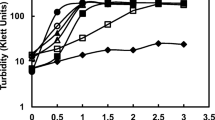Abstract
The properties of bacterial isolates from polluted environments which are characterized by increased levels of oxidative stress do not reflect only the level of contaminants, but also arise as a consequence of many permanently changed conditions. The survival rate of Comamonas terrigena N3H isolates from an environment with elevated levels of H2O2 is correlated with stimulation of catalase. The response of bacterial catalase to the effect of phenol in exogenous conditions was affected by the presence of an additional contaminant, Cd2+. An isolate of Aspergillus niger selected from river sediment containing 363 mg/kg As, 93 mg/kg Sb at pH 5.2–4.8 grew on Czapek-Dox agar ~1.6 times faster than an isolate of the same species from coal dust sediment with approximately the same level of pollution (400 mg/kg As) but somewhat lower pH (3.3–2.8). It also exhibited differences in the microscopic characteristics of its mycelial structures. Both isolates exhibited a higher tolerance to the exogenic toxic effects of metals (As5+, Cd2+, and Cu2+ at 5, 25, or 50 mg/L) than a control culture, but the differences in tolerance between them were only slight. These laboratory results suggest that there are complicated relationships which may exist in the “in situ” environment.


Similar content being viewed by others

References
Baker KH, Herson DS (1994) Microbiology and biodegradation. In: Baker KH, Herson DS (eds) Bioremediation. McGraw-Hill, New York, pp 9–60
Bradford MM (1976) A rapid and sensitive method for the quantitation of microgram quantities of protein utilizing the principle of protein-dye binding. Anal Biochem 72:248–250
Bučková M, Godočíková J, Šimonovičová A, Polek B (2005) Production of catalases by Aspergillus niger isolates as a response to pollutant stress by heavy metals. Curr Microbiol 50:175–179
Bučková M, Godočíková J, Polek B (2007) Responses in the mycelial growth of Aspergillus niger isolates to arsenic contaminated environments and their resistance to exogenic metal stress. J Basic Microbiol 47:295–300
Bučková M, Godočíková J, Zámocký M, Polek B (2010) Screening of bacterial isolates from polluted soils exhibiting catalase and peroxidase activity and diversity of their responses to oxidative stress. Curr Microbiol 61:241–247
Bučková M, Godočíková J, Zámocký M, Polek B (2010) Isolates of Comamonas spp. exhibiting catalase and peroxidase activities and diversity of their responses to oxidative stress. Ecotoxicol Environ Saf 73:1511–1516
Dowds BCA, Murphy P, McConnel DJ, Devine KM (1987) Relationship among oxidative stress, growth cycle, and sporulation in Bacillus subtilis. J Bacteriol 169:5771–5775
Godočíková J, Boháčová V, Zámocký M, Polek B (2005) Production of catalases by Comamonas spp. and resistance to oxidative stress. Folia Microbiol 50:113–118
Godočíková J, Zámpocký, Bučková M, Obinger C, Polek B (2010) Molecular diversity of katG genes in the soil bacteria Comamonas. Arch Microbiol 192:175–184
Ferianc P, Polek B, Godočíková J, Tóth D (1995) Metabolic activity of cadmium-stressed and/or starved Vibrio sp. Folia Microbiol 40:443–446
Ichise N, Hirota K, Ichihashi D, Nodasaka Y, Morita N, Okuyama H, Yumoto I (2008) H2O2 tolerance of Vibrio S-1(T) is attributable to the cellular catalase activity. J Biosci Bioeng 106:39–46
Jenkins DE, Schultz JE, Matin A (1988) Starvation-induced cross-protection against heat and H2O2 challenge in Escherichia coli. J Bacteriol 170:3910–3914
Paar A, Costa S, Tzanov T, Gudelj M, Robra KH, Cavaco-Paulo A, Gubitz GM (2001) Thermo-alkali-stable catalases from newly isolated Bacillus sp. for the treatment and recycling of textile bleaching effluents. J Biotechnol 89:147–153
Prokšová M, Vrbanová A, Augustín J (1996) Enrichment, isolation and characterization of dialkyl sulfosuccinate degrading bacteria Comamonas terrigena N3H and Comamonas terrigena N1C. Folia Microbiol 42:635–639
Roggenkamp R, Sahm H, Wagner F (1974) Microbial assimilation of methanol induction and function of catalase in Candida boidinii. FEBS Lett 41:283–286
Sharpley AN (1991) Effect of soil pH on cation and anion solubility. Commun Soil Sci Plant Anal 22:1391–1399
Stohs SJ, Bagchi D (1995) Oxidative mechanisms in the toxicity of metal ions. Free Radic Biol Med 18:321–336
Stojnev T, Harichová J, Ferianc P, Nyström T (2007) Function of a novel cadmium-induced YodA protein in Escherichia coli. Curr Microbiol 55:99–104
Takenaka S, Mulyono S, Sasano Y, Takahashi Y, Murakami S, Aoki K (2006) Microbial transformation of aniline derivates: regioselective biotransformation and detoxification of 2-phenylenediamine by Bacillus cereus strain PDa-1. J Biosci Bioeng 102:21–27
Zámocký M, Godočíková J, Koller F, Polek B (2001) Potential application of catalase-peroxidase from Comamonas terrigena N3H in the biodegradation of phenolic compounds. Antonie Van Leeuwenhoek 256:169–182
Acknowledgments
This study was supported by the Grant 2/0149/11 of VEGA (Slovak Science fund).
Author information
Authors and Affiliations
Corresponding author
Rights and permissions
About this article
Cite this article
Polek, B., Godočíková, J. The Effect of Some Factors of Polluted Environment on Catalase Responses and Resistance of Microbial Isolates Against Toxic Oxidative Stress. Curr Microbiol 65, 345–349 (2012). https://doi.org/10.1007/s00284-012-0163-y
Received:
Accepted:
Published:
Issue Date:
DOI: https://doi.org/10.1007/s00284-012-0163-y


